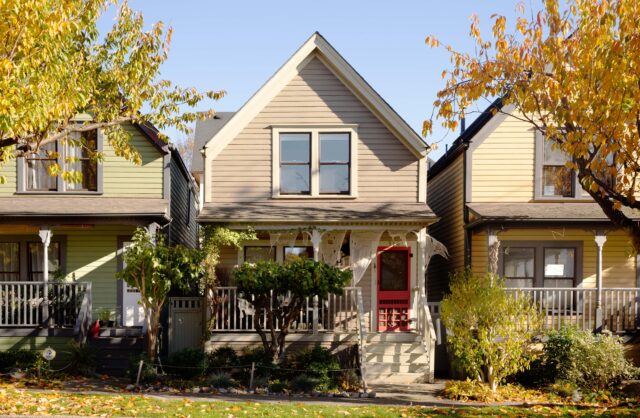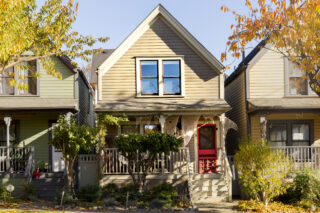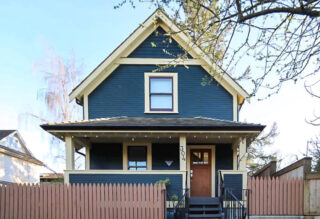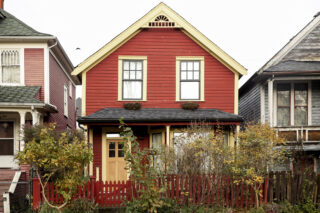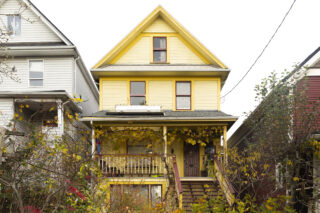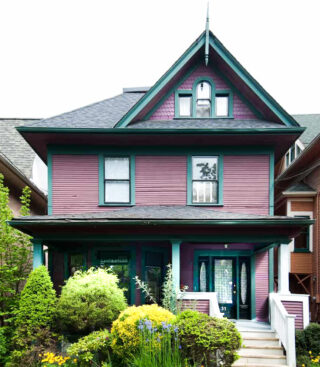Gabled Vernacular roofs were usually made of cedar shingles. Siding was usually drop siding with a pronounced channel or concave cove shape at the top of the board.
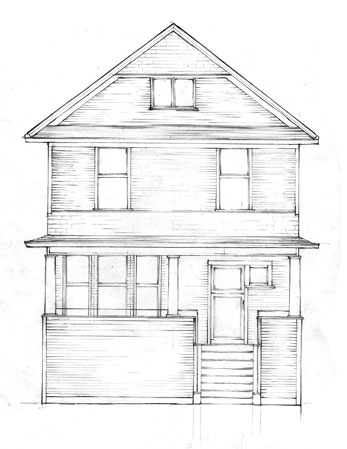
Click on the diagram or expand the term index to learn more about the features.
Cladding
Also referred to as siding, cladding is the outermost layer of the wall system, providing resistance to the natural elements and acting as a control device for drainage. Depending on the house style, various kinds of stucco, horizontal and vertical boards may be used as cladding. Types of cladding/siding: Board and Batten Clapboard Drop Lap Masonry Shakes Shingle Shiplap Stucco
Column
A supporting post, generally round. In classical orders, the column consists of a base, shaft, and capital.
Double Hung Window
A pair of superimposed wooden sashes that are offset so as to slide up and down within the same frame. A double hung window that has horns on its upper sash are most likely pre World War I.
Gable Roof
A pitched roof that ends in a gable (the triangular portion of a wall defined by the sloping edges of the roof and a horizontal line between the eave line).
Porch
A covered platform, usually with its own roof, attached to a building, serving as a covered entryway. May be limited to covering the front door area or may extend along the full length of the façade.
Trim Board
Wooden boards that are typically used to illustrate the separation between floors and accent other components on the exterior such as windows and doors.
Form
The most common surviving houses of old Vancouver, Gabled Vernaculars are 1-1/2 to 2-1/2 stories tall with front-gabled roofs; the roof may have a skirt across the bottom of the gable. In this style, the house is usually set a half to a full storey above the ground (due to the basement space required for central heating). Its full-width front porch commonly has a hipped roof held up by posts (typically round Tuscan-style). The front door is almost always set on one side of the facade in line with the front stairs and there may be a bay window on one side of the porch, sometimes repeated on the upper storey. Dormers may be hipped or gabled. Examples of the style usually have very few decorative elements such as brackets and fretwork.
Background
The Gabled Vernacular style drew on several popular styles, adapted them for simpler homes for everyday living in the late 19th – early 20th century. Following the rise of the Greek revival movement in the 19th century, gable-fronted houses became more common, with designs that echoed the pediments of ancient Greek temples. This style gained popularity for American homes between 1830 and 1850. Pre-fabricated houses like many of the BC Mills houses and mail-order plans made the style easy to access. Gabled Vernacular homes were common in Vancouver since their narrow two-storey form made front-gabled houses well suited for urban lots. Today, the style is one of the most common historical house styles left in the city.
Details
- Steeply pitched, front-gabled roof
- Often roof skirt across bottom of gable
- Usually 2 to 2-1/2 storey
- Full-width porch
- Set a half- to full-storey above ground
- Few decorative elements
- Drop siding or narrow lap siding, sometimes shingles
